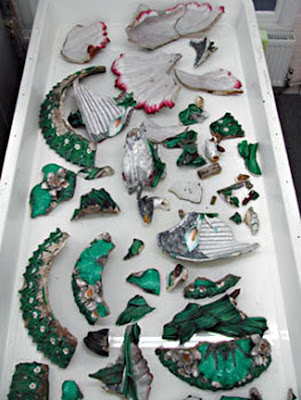A reader recently asked us a question concerning pottery repair and it occurred to us that on our blog we've never addressed the different kinds of repair available to the antique pottery collector.
Today, most repairs we see are purely cosmetic in nature. Using a piece that has a decorative repair will cause damage to the repair. A professional restorer will use modern adhesives, pigments and fillers to return a piece to its former glory. An important point to remember is to choose a restorer who will repair a piece so as to not compromise the integrity of the original object. Any repair should be completely removable without damaging the item. We have shown the work of several restorers previously on our blog here, here and here. All of these are decorative. None restore the usefulness of the original object but when you have a choice between this:
Most damaged pieces of pottery will benefit from pottery repair. Damage to any piece will compromise its value but a good repair could help to restore some of that value, particularly in soft earthenware and majolica where such damage is common. There are basically two types of repair: functional and cosmetic. In the days before modern adhesives when objects were harder to replace than they might be today most repairs were done to restore the usefulness of an object. This would be functional repair.
The most common type of functional repair one sees is staple repair where a thick metal staple was inserted into the body of the pottery to support whatever damage may have been done. These repairs were done commonly up until the 1950's but their history dates back hundreds of years. They are quite remarkable when you think about the fragile material involved. The process itself is actually very simple. The two sides of the object to be repaired were solidly bound together using a sturdy twine. A small shallow metal staple with prongs pointing slightly inward was fashioned to hold the pieces together. On either side of the damaged area two small holes were drilled with a diamond bit at a 90 degree angle to the surface of the pottery where the staple prongs were intended to be inserted. The staple was then heated, causing the metal to expand and be more flexible. It was then inserted into the two drilled holes and allowed to cool. Once cooled the metal would contract forming a tight bond between the two pieces.
A second type of functional repair uses metal to replace a missing section. This type of repair is often referred to as a "make do." Most commonly these are seen replacing sections of spouts or handles that are missing. Either a frame or a piece of metal is fashioned to replace the missing piece. It is then attached by small pegs to the pottery body in the same manner in which staples are inserted. These kinds of repairs are usually quite charming in their inventiveness as they are often done by amateurs. Some people even specialize in collecting "make dos" because of their gentle folksy look.
 |
| Make do repair |
 |
| Make do repair |
A type of repair used in Japanese ceramics which we have never seen in Western culture is called Kintsugi. In Kintsugi, lacquer is mixed with gold or other metallic powder to make a liquid bond that glues the pieces together. The resulting piece is often more valuable than the original ceramic because of the beauty of the finished product as well as the precious metal used in the repair.
 |
| Kintsugi type repair |
and this:
 |
| Retored Minton fountain base. Photos courtesy of Sarah Peek. |
its appeal is obvious.
The Majolica International Society maintains a list of restorers who specialize in majolica on their Web site, but most of them can repair other bodies as well. Local restorers can also be found through a reference from local antique dealers or through an inquiry of your local chamber of congress.






No comments:
Post a Comment